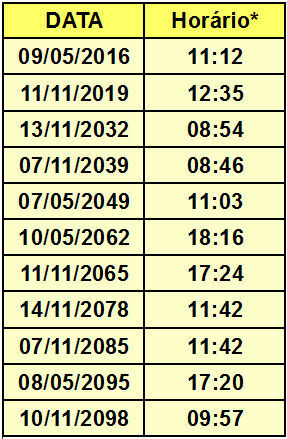The call transit of Mercuryis the name given to the passage of the planet Mercury in front of the Sun. The same phenomenon occurs with the planet Venus, configuring what we know as Transit of Venus. The visual effect is of a small black spot on the Sun that, over time, moves until it crosses the entire solar disk.
This phenomenon occurs with the planets Mercury and Venus because they have an orbit smaller than Earth's orbit. For this reason, when the orbits of Earth and these planets coincide, we can see them passing in front of the Sun. as the orbits of Mars, Jupiter, Saturn, Uranus and Neptune are bigger than Earth, we will never be able to see the transit of these planets.
Discovery of the phenomenon
The transit of Mercury and Venus began to be observed from the 17th century onwards with the work of the astronomer Johannes Kepler, responsible for enunciating three laws that show the behavior of planets around the Sun. The transit of planets not only contributed to Kepler's work, but also made it possible to predict the occurrence of these phenomena.
English astronomer and mathematician Jeremiah Horrocks was the first to observe and make relevant notes on the transit of Venus that occurred in December 1631.
Frequency of occurrence
The occurrence of the transit of Mercury and Venus depends on the alignment of the orbits of these planets with the Earth's orbit. As Mercury is closer to the Sun, it has a short translation period, about 88 days. Thus, the occurrence of its transit is more frequent. Venus takes 243 days to complete a spin around the Sun, and every 19 months it passes between the Sun and Earth. However, its transit can only be observed if the orbits are aligned. The last transit of Venus took place in June 2012 and the next one will only take place in December 2117!
Do not stop now... There's more after the advertising ;)
The table below shows the dates of occurrence of the next transits of Mercury that can be seen in Brazil and the times when the phenomenon can be observed.

* Time in UTC
Note that the transit of Mercury will occur in May or November with an average occurrence of approximately eight years.
How to observe the phenomenon
You won't need a telescope to see the occurrence of this astronomical phenomenon, but directly observe the Sun without the use of equipment can cause damage to eyesight, so safety measures must be taken to protect the eyes. There are specific filters placed on telescopes, types of glass and masks capable of blocking the sun's rays and allowing direct observation of the star. There is still the option of indirect observation of the phenomenon from the projection of the Sun's image onto a screen.
By Joab Silas
Graduated in Physics
Would you like to reference this text in a school or academic work? Look:
JUNIOR, Joab Silas da Silva. "Transiting Mercury and Venus"; Brazil School. Available in: https://brasilescola.uol.com.br/fisica/transito-mercurio-venus.htm. Accessed on June 27, 2021.
